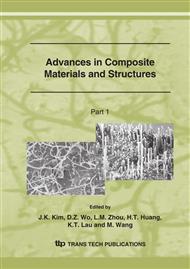p.513
p.517
p.521
p.525
p.529
p.533
p.537
p.541
p.545
Measurement of Thermal Expansion Coefficients of a Thin Film of Different Ceramic Coatings by Shearography
Abstract:
In the present work, thermal expansion coefficients of a number of ceramic coatings were studied by a non-destructive technique (NDT) known as shearography. Ceramic coatings, i.e., a white enamel and a yellow Acrylic Lacquer on a metallic alloy, i.e., carbon steels, were investigated at a temperature range simulating the severe weather temperatures in Kuwait, especially between the daylight and the night time temperatures, 20-60 0C. The investigation was focused on determining the in-plane displacement of the coating, which corresponds to the thermal deformation (strain), with respect to the applied temperature range. A mathematical relationship was derived along with the experimental data. The mathematical relationship described the thermal deformation of a coated film as a function of temperature. Furthermore, results of shearography indicate that the technique is found very useful NDT method not only for determining the thermal expansion coefficients of different coatings, but also the technique can be used as a 2D- microscope for monitoring the deformation of various coatings in at a submicroscopic scale.
Info:
Periodical:
Pages:
529-532
Citation:
Online since:
March 2007
Authors:
Price:
Сopyright:
© 2007 Trans Tech Publications Ltd. All Rights Reserved
Share:
Citation:


